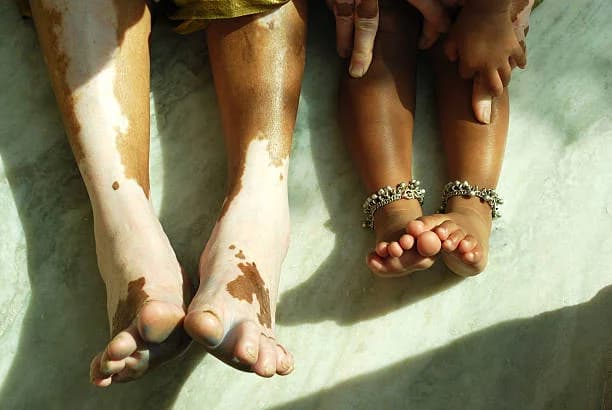Vitiligo is a chronic (long-lasting) skin condition where patches of skin become pale or white, affecting 1 to 2 in every 100 people. This happens when melanocytes (skin cells that make pigment) are attacked and destroyed, causing the skin to lose its color.
Vitiligo skin condition
Vitiligo may affect people of any age, gender, or ethnicity. Usually, this is a lifelong condition and there are currently no cures for it. As of now the exact cause of vitiligo is unknown, but it may be due to an autoimmune disorder or a virus. Vitiligo is not contagious. Loss of pigment may develop on every part of your body including:
- sun-exposed areas, like the hands, feet, arms, and face
- inside the mouth or other mucus membranes
- nostrils
- genitals
- back of the eye
- within the hearing system of the ear
Your hair may also turn gray or white if the areas involved have hair.

There are 2 types of vitiligo
Common vitiligo: Starting as isolated pale or white spots, with more spots or patches appearing over time.
Segmental vitiligo: Only affecting one area of skin, generally across an area no bigger than the palm of an adult’s hand. Segmental vitiligo does not spread, is less common, and usually occurs in childhood.
What are the symptoms of vitiligo?
Vitiligo’s symptoms usually appear in patients' 20s or 30s but may occur in childhood or older life. Vitiligo patches can develop in areas where the skin has been damaged, such as a cut or burn. In places where the skin rubs together such as under the arms, in the groin, and between the buttocks vitiligo may appear.
Also, body parts that are exposed, such as the face and hands are at risk. During times of distress, stress, illness, or pregnancy vitiligo may progress to other parts of the body. These patches may suddenly get their pigment back. But other than the physical aspects, people with vitiligo usually don’t have other problems and have good health.

What causes vitiligo?
The cause of vitiligo is unclear, though it is thought to be an autoimmune condition, where the immune system attacks the cells that form pigment. Vitiligo may worsen if you have an injury to the skin or stress.
Who Gets Vitiligo?
Anyone could get vitiligo at any age. For many people with vitiligo, the white patches begin to appear before age 20. It also seems to be more common in those with a family history of the disorder or those with certain autoimmune diseases, such as:
Addison’s disease
Pernicious anemia
Psoriasis
Rheumatoid arthritis
Systemic lupus erythematosus
Thyroid disease
Type 1 diabetes

Symptoms of Vitiligo
The main symptom of vitiligo is loss of natural color or pigment, called depigmentation. The depigmented patches can appear anywhere on your body and can affect:
Skin, develops milky-white patches, usually on the hands, feet, arms, and face. However, the patches can appear anywhere.
Hair can turn white in areas where the skin is losing pigment. This can happen on the scalp, eyebrows, eyelashes, and beard.
Mucous membranes, such as the inside of your mouth or nose.
People with vitiligo can also develop:
Low self-esteem or a poor self-image from concerns about appearance, can affect the quality of life.
Uveitis is a general term that describes inflammation or swelling in the eye.
Inflammation in the ear.

How is vitiligo treated?
Mainly because of the way the skin looks, vitiligo may be challenging to live with. Although those with vitiligo are usually in good health and live normal lives. If vitiligo is not followed by symptoms causing physical discomfort which would need other treatments, there are 3 main treatment options for vitiligo:
Camouflage using makeup and dyes to conceal affected areas.
Using treatments to reduce inflammation, destroy the pigment cells, or encourage neighboring cells to produce more pigment. This may be in the form of cortisone creams or ointments put on the skin / light therapy / creams that work when light is applied / medications called tacrolimus, pimecrolimus, or calcipotriol.
Re-pigmentation transfers a person’s pigment cells to the areas affected by vitiligo. This is done with surgery.
Depigmentation involves removing pigment from the remaining areas of unaffected skin to create a consistent skin color.
A dermatologist can help you treat and manage your vitiligo if it bothers you.
Conclusion
In conclusion, vitiligo is a chronic autoimmune disorder that causes patches of skin to lose pigment or color. The cause of vitiligo is unknown, but it may be related to immune system changes, genetic factors, stress, or sun exposure. The condition is characterized by the presence of pale patchy areas of depigmented skin which tend to occur on the extremities. The patches are initially small, but often grow and change shape. Although vitiligo can start at any age, it usually appears before age 30. Treatment options for vitiligo include topical medications, light therapy, surgery, and cosmetics. Despite the potential psychological impact of the condition, with early diagnosis and appropriate treatment, individuals with vitiligo can lead healthy lives.
Read more: